#Myliobatiformes
Explore tagged Tumblr posts
Text
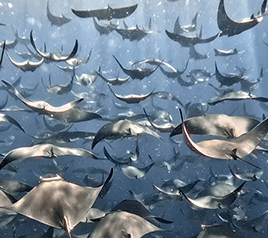
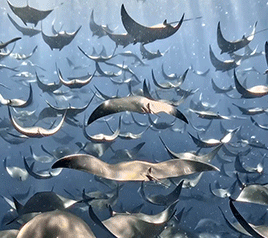
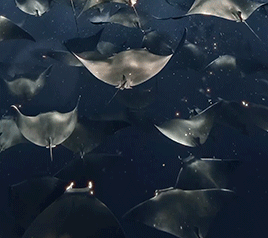
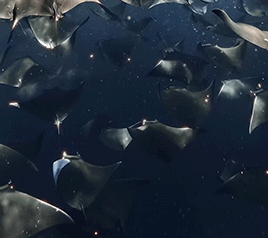
"The magic of the mobula ray migration." ©Aidan Bedford
7K notes
·
View notes
Text

Spotted Eagle Ray (Aetobatus narinari), family Aetobatidae, order Myliobatiformes, off the coast of NC, USA
ENDANGERED.
photograph by Jean St. Arnauld
#eagle ray#ray#aetobatus#aetobatidae#elasmobranch#myliobatiformes#fish#ichthyology#animals#nature#north america#ocean
1K notes
·
View notes
Text

Lessiniabatis aenigmatica was a rather strange stingray.
It lived around 50-48 million years ago during the early Eocene, in a shallow warm sea covering what is now Italy, with its three known fossil specimens all coming from the fish-rich Monte Bolca fossil beds.
About 60cm long (~2'), it had a round pancake-like body similar to many modern seafloor-dwelling stingrays – but uniquely it was also almost tailless, with only a tiny, slender, stingless tail.
It wasn't a particularly strong swimmer, instead probably spending most of its time buried in the muddy seafloor sediment. When on the move it likely swam along just above the surface of the seafloor using undulations of its fins, foraging for smaller bottom-dwelling animals like worms, molluscs, crustaceans, and fish.
—
NixIllustration.com | Tumblr | Patreon
#science illustration#paleontology#paleoart#palaeoblr#lessiniabatis#dasyatoidea#myliobatiformes#stingray#batoidea#ray#elasmobranch#chondrichthyes#cartilaginous fish#fish#art#sea pancake
520 notes
·
View notes
Text
Taxonomy Tournament: Cartilaginous Fish Finale!
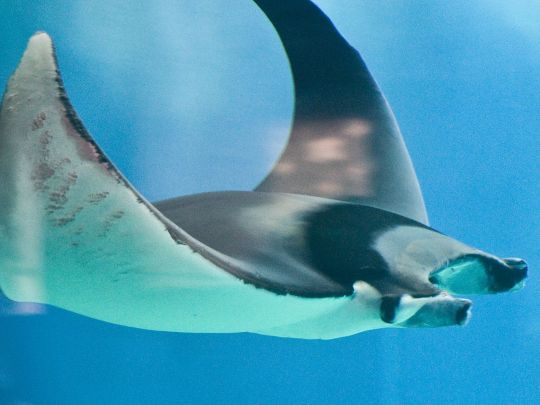
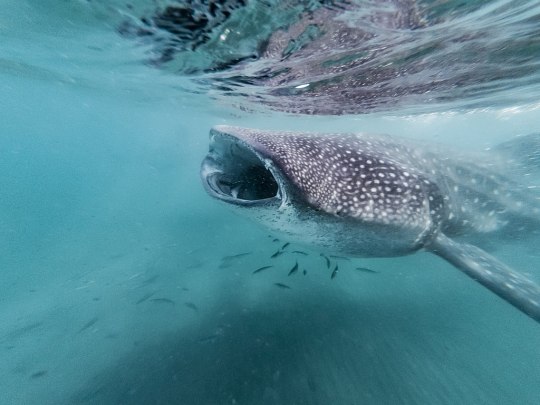
Myliobatiformes. This order of batoids includes stingrays and manta rays.
Orectolobiformes. This order is known as the carpet sharks. Members include nurse sharks, whale sharks, and Wobbegong sharks
#animals#biology#polls#poll tournament#zoology#Animal Tournament Round 4#stingrays#manta rays#fish#rays#nurse sharks#whale sharks#sharks#Myliobatiformes#Orectolobiformes#0xev0xf
259 notes
·
View notes
Note
went throught the IUCN critically endangered and endangered list and here's some i wanted to share (you dont have to do these in order or all in a row or anything)
ornate eagle ray
maui parrotbill
lemur leaf frog
giant bronze gecko
talaud bear cuscus
antiguan racer
Great choices! I'll probably do them all in a row, just to keep track :)


#critically endangered#indopacific ocean#ornate eagle ray#eagle ray#ray animal#chondrichthyes#elasmobranch#myliobatiformes#myliobatidae#animal polls#poll blog#my polls#animals#polls#tumblr polls
38 notes
·
View notes
Photo

A bluespotted ribbontail ray (Taeniura lymma) off the coast of Safaga, Egypt
by Kary Mar
#bluespotted ribbontail ray#rays#stingrays#fish#cartilaginous fish#Taeniura lymma#taeniura#dasyatidae#Myliobatiformes#Chondrichthyes#chordata#wildlife: egypt#wildlife: africa
448 notes
·
View notes
Text


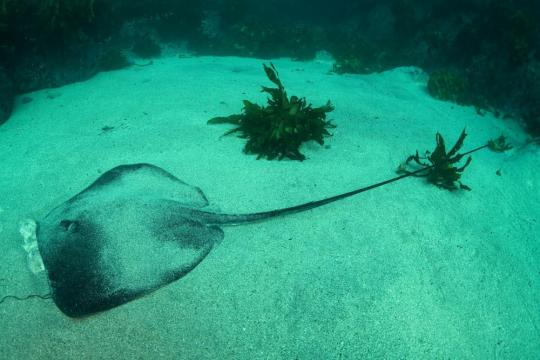
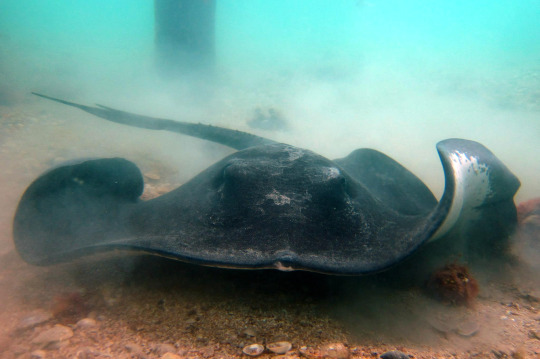
A Stingray Abroad: The Broad Stingray
Bathytoshia lata is a stingray known by many names: the broad stingray, the brown stingray, and thorn tail stingray; Dasyatis lata, Dasyatis thetidis, and Dasyatis ushii. The species has accumulated all these names-- and quite a few others-- thanks to its broad distribution. It can be found in the Atlantic, Pacific, and Indian Oceans, as well as the Mediterranean sea. Typically the species stays on reefs or in coastal bays with muddy bottoms. Prior to 2012, genetic testing of stingray species revealed them to be populations of B. lata, hence the multitude of latin names.
The broad stingray is one of the largest species of stingrays; the average individual is about 1.5 m (5 ft) across and 56 kg (123 lb), with some populations reaching an excess of 2.6 m (8.5 ft) across and 290 kg (639 lbs). Females also tend to be larger than males. The body is diamond shaped, and the tail is often more than twice its length. B. lata is dark in color, often tan or black, with a white underbelly. Perhaps its most distinctive feature are the 'spines'-- also known as dermal denticles-- that line the tail and rear portion of the body, giving it the name 'thorn tail'.
The brown stingray is fairly docile, and spends most of the day lying inactive on the sea bed. At night they forage for crustaceans, polychaete worms, and small fish. They can use their powerful pectoral fins to burrow through the sand and uncover prey, and like sharks they have special organs called ampullae of Lorenzini that allow them to detect electrical fields emitted by their prey. The primary predator of B. lata is the hammerhead shark, and when threatened individuals will raise the spines along their tail to deliver whip-like blows.
Females become ready to mate in the summer, typically from November to March. Males are attracted to pheromones released by the female, and initiate a dance-like courtship ritual. If the female is receptive, he will bite down on her pectoral fins while grasping her with special claspers located at the base of the tail. Following the mating ritual, the female gestates her young internally for 10-12 months. This species is ovoviviparous, and the pups recieve nutirents from both a yolk and internally secreted milk. Following her pregnancy, the mother gives birth to live young, typically 3-4 in a litter. The pups are completely independent, and receive no parental care after being born. It takes them about 14-16 years to become fully mature, and individuals can live up to 28 years in the wild.
Conservation status: The broad stingray is considered Vulnerable by the IUCN. Its most common threat comes from being caught as by-catch in fishing nets, and intentionally for their meat and skin.
If you like what I do, consider leaving a tip or buying me a kofi!
Photos
Andy Murch
Sarah Speight
Andrew Green
Phillipe Guillaume
#broad stingray#black stingray#Myliobatiformes#Dasyatidae#whiptail stingrays#stingrays#rays#cartilaginous fish#fish#marine fauna#marine fish#coral reefs#coral reef fish#benthic fauna#benthic fish#coasts#coastal fish#Atlantic Ocean#Indian Ocean#Pacific Ocean#Mediterranean sea#animal facts#biology#zoology#ecology
97 notes
·
View notes
Text
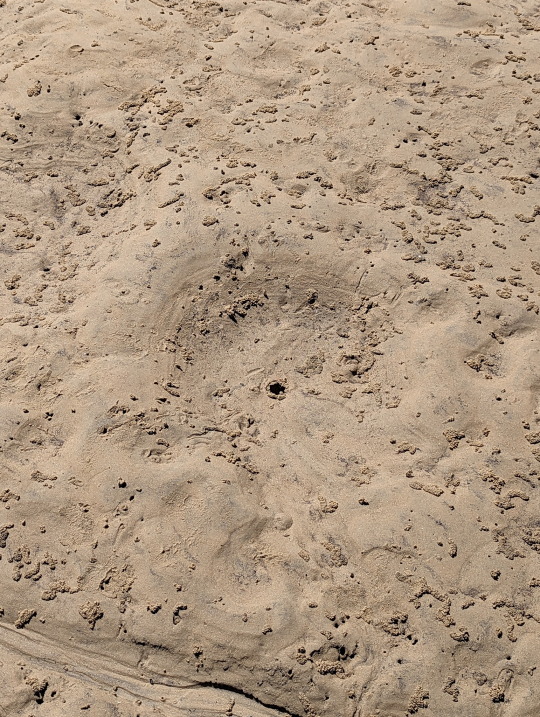
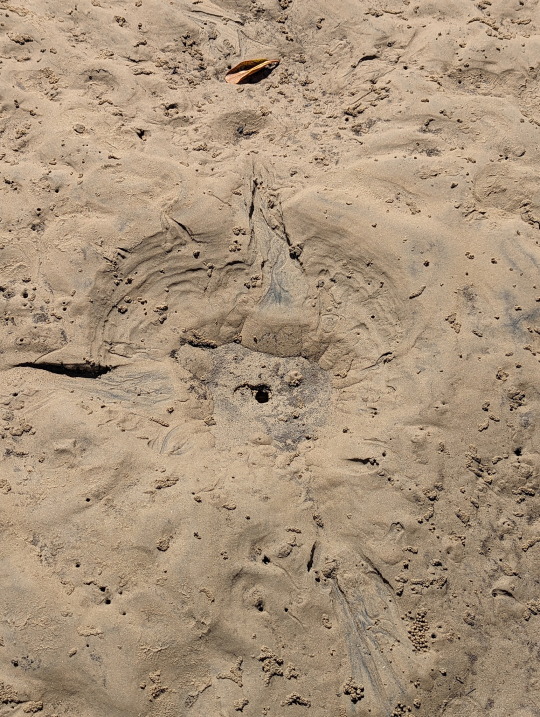


Stingray feeding pits (ignore the holes in the centre, that's from GPS equipment).
The stingrays would come to Leeke's Estuary at high tide to feed. To hunt any sediment-dwelling organisms, the stingrays would dig into the sand, displacing a large amount of sediment in the process. This left large distinct holes across the estuary's sediment.
This impacts the ecosystem in a few interesting ways, such as the recolonization of pits by various organisms (VanBlaricom 1982).
More information:
VanBlaricom GR 1982 ‘Experimental Analyses of Structural Regulation in a Marine Sand Community Exposed to Oceanic Swell’ Ecological monographs vol. 52 no. 3 pp. 295-302.
O’shea OR, Thums, M, Keulen, MV, Meekan, M 2012, ‘Bioturbation by stingrays at Ningaloo Reef, Western Australia’, Marine and freshwater research, vol. 63, no. 3, p. 195.
12/09/23 - Myliobatiformes sp.
QLD:CQC, Woppa (Great Keppel Island), Leeke's Estuary, coastal mangrove forest
#Myliobatiformes#Stingrays#Vertebrata#Vertebrates#Chordata#Chordates#Elasmobranchii#Elasmobranchs#rays#marine biology
18 notes
·
View notes
Photo
im sad this account hasnt been updated in 11 years :(



Leopard whipray - Himantura leoparda
Encountered in the Indo-Pacific from South Africa to Australia, the leopard whipray has a striking pattern of dark brown rings on its dorsal side that gave it its name. Like all species in the Himantura genus, known as the whiprays, it has a very long, thin tail that lacks a dorsal or caudal fin and can measure more than three times the length of its disc. Adults can reach approximately 5.9ft in width and a total length of about 13ft with an intact tail. Due to confusion with the closely related honeycomb and reticulate whiprays, the leopard whipray is not well known. It is heavily fished in parts of Indonesia for its meat and possibly other parts using bottom trawls, tangle nets, and longlines, and has not been classified by the IUCN at this time.
25 notes
·
View notes
Text





44 notes
·
View notes
Text
This is based on a request that I accidentally lost, I'm sorry but here's your request, stingray!yuu. Sorry if it did not satisfy you
Ask and you shall receive
𝐃𝐎𝐑𝐌𝐒 𝐖𝐈𝐓𝐇 𝐒𝐓𝐈𝐍𝐆𝐑𝐀𝐘!𝐘𝐔𝐔 🫧🐚


Stingrays are a group of sea rays, a type of cartilaginous fish. They are classified in the suborder Myliobatoidei of the order Myliobatiformes and consist of eight families: Hexatrygonidae, Plesiobatidae, Urolophidae, Urotrygonidae, Dasyatidae, Potamotrygonidae, Gymnuridae and Myliobatidae.
Due to their species known for their dangerous tail, stingray!You grow up isolated and lonely. Without a friend to rely on after their attendance into NRC, the loneliness is still there but soon it started to fade away by meeting people who are willing to understand them
Octavinelle
Azul : Initially sees them isolated presence as a business opportunity. He’s intrigued by how people are cautious around them and thinks this could be an advantage for him, especially in shady dealings where intimidation is useful. He attempts to recruit them to work for the Mostro Lounge, believing their mysterious vibe will draw in curious customers. Over time, he grows to appreciate their loyalty and reserved strength, though he’s also careful not to underestimate them.
Jade: Is fascinated by them from the very beginning. He finds their quiet, observant nature similar to his own approach to life. Jade often strikes up conversations with them a surprise for them, watching how they react and learning more about their quiet resilience. He’s one of the few who never seems fazed by their aura and tail, instead viewing them as a rare creature of the deep, much like the unusual flora and fauna he enjoys studying. Them and Jade share a mutual understanding without needing to say much.
Floyd : Immediately calls them “Stingray-chan” and makes a game out of trying to get them to react. He enjoys teasing them, poking fun at how quiet and “spooky” they are. Despite his playful taunts, Floyd actually finds them interesting, often trying to figure out what makes them tick. When he’s in a good mood, he’ll drape his arm over their shoulders and refer to them as his “stingray buddy,” though in bad moods, he might try to provoke them just for fun. for their part, usually stays calm under Floyd’s antics, which only amuses him more.
IGNIHYDE
Idia shroud : both of them are introverts, one desire to communicate with people while the other one avoids all communication with people, both of them find games found and hang out with each other just to play video games, he doesn't mind their tail since you could just avoid it he doesn't find what's wrong with people and their tail.
Ortho : he was glad that his brother found a real life friend instead in front of the screen, he even thanks stingray!yuu for pushing him out to interact with people. He also protects stingray!yuu from any unnecessary bullying or comments from mean students.
DISMONIA
Malleus : understand each other,drawn in by their quiet strength and resilience. Like himself, he feels an instinctive connection to someone who understands the weight of being misunderstood. they often face misunderstanding from others, and he appreciates how they navigate the world with grace despite being viewed as strange. Malleus often protects them from unwanted attention, creating a safe space where they can be themselves without fear of judgment. In moments of solitude, he shares stories about his own experiences of loneliness, fostering a connection that transcends words. They would go out for walks together venting to each other about their loneliness making each other their comfort zone.
Lilia : Find them aura both intriguing and amusing. He enjoys teasing them, trying to draw out their reactions with playful banter and lighthearted pranks. Lilia senses that beneath their quiet exterior lies a vibrant spirit waiting to shine through, so he often encourages them to step outside their comfort zone, inviting them to join in the dorm's chaotic moments. As time passes, Lilia becomes one of the few who can make them smile genuinely, often referring to them as “his precious little stingray.”
Sebek : misunderstood them similar towards the others but grew to understand him, originally called them fish Mut when they visit dismonia to hang out with malleus, but was stopped by Lilia before it can escalate before malleus know about sebek insult to his dear friend, after that hang out he came to your table and apologies to you. Saying that he should have understood more about them instead based them on how people know them. As well started to hang out with them he vents about malleus and they just sit there and listen, the first person that listens to him. Is willing to understand them more.
Silver : Silver admires their determination to remain kind despite the misunderstanding, and they often engage in conversations about dreams and aspirations. They finds solace in Silver’s steady presence, and they often have deep, contemplative talks, appreciating the moments of peace amid the chaos of school life.
#not canon#twisted wonderland#twst headcanons#twst scenario#disney twst#twisted wonderland yuu au#twst mc#twst wonderland#twst x reader#twst yuu au#stingray!yuu
72 notes
·
View notes
Text
I can’t believe it. We’re finally here. Round 3 starts tomorrow (2/1), with our first poll dropping at 8 am EST.
Some notes:
Round 3 will be our biggest round yet, and I have 227 polls scheduled. That’s almost a year’s worth of polls. It should be obvious that not every Order is going to make it to Round 4. So you’re going to need to be more choosy this round. Be honest. Come here with a plan. Do a bit of research. Know your favs. This next round is covering Animal Orders. If your favorite animal is a Great White Shark you need to know that it’s a Lamniform. So you should make sure you’re only voting fav in the Lamniformes poll and not fav in the other shark polls. You can still vote love or like in those polls; that’s what those options are there for. But this round is going to require a bit more focus if we want a diverse roundup next year! If you’re someone who votes favorite in every poll, try to pick just one or two favorites from each class we’re covering. I would actually love if we could have at least one representative from each class moving forward. (That being said, don’t be afraid to reflect it in your vote if the descriptions and propaganda have you discovering new favorites! I’m kinda hoping for that here too!)
I can not state enough that this tournament relies on numbers. If you want your fav to move forward you have to make sure people see it. Reblog, post propaganda, etc. If you don’t have a large following, reblog the poll anyway, add some GOOD propaganda onto it, and then chances are I’ll reblog it which increases the chances of it getting seen again. Get your friends involved. If you know someone that only blogs about squids, tag them! This tournament is all about PASSION.
I had some complaints last round about missing some polls. These polls are all pre-scheduled. They post once a day, at 8am EST, and they’re open for 7 days. If you click on the tag #/Animal Polls while within my blog, you can see every poll in one place. I recommend doing that every so often so you don’t miss any of them! You can also turn on notifications or follow the blog via rss (but that also means your gonna be seeing asks, extra propaganda, and poll results as well.) On top of that, I will post a schedule of every single poll at the bottom of this post, under the read more. If there are polls you absolutely do not want to miss, put them in your calendar!
That being said, there is ONE BIG CHANGE this round. I am removing the hate option. I put the dislike and hate options there as a fun little mechanic to strategize and steal points from other people but uh… I’m ngl, it’s starting to Hurt My Feelings. Whoopsie. The dislike option will remain but I feel like hate is a bit too strong of an option to include. The fact that dislike, neutral, and simply not voting already detract points from the total seems like enough. ¯\_(ツ)_/¯
Still, as always, this is just a silly Tumblr tournament that doesn’t really matter in the long run. Nothing’s going to happen to the animals that make it to the next round and nothing’s going to happen to the animals that don’t, we’re just trying to figure out the most popular animal on Tumblr. If your favorite doesn’t make it, that’s okay! If anything, that just makes it, and you, all the more unique! And if it does? Welcome! You’ve found your people!
Poll Schedule under the read more
(Warning: It Big)
Polls will post once a day at 8am US EST.
Chondrichthyes:
Carcharhiniformes - Feb 1
Lamniformes - Feb 2
Orectolobiformes - Feb 3
Heterodontiformes - Feb 4
Squaliformes - Feb 5
Squatiniformes - Feb 6
Pristiophoriformes - Feb 7
Hexanchiformes - Feb 8
Myliobatiformes - Feb 9
Rajiformes - Feb 10
Rhinopristiformes - Feb 11
Torpediniformes - Feb 12
Chimaeriformes - Feb 13
Chondrichthyes Round-up and Mini Stat Post - Feb 20
Mammalia:
Monotremata - Feb 21
Didelphimorphia - Feb 22
Paucituberculata - Feb 23
Microbiotheria - Feb 24
Dasyuromorphia - Feb 25
Peramelemorphia - Feb 26
Notoryctemorphia - Feb 27
Diprotodontia - Feb 28
Macroscelidea - Mar 1
Afrosoricida - Mar 2
Tubulidentata - Mar 3
Proboscidea - Mar 4
Hyracoidea - Mar 5
Sirenia - Mar 6
Cingulata - Mar 7
Pilosa - Mar 8
Scandentia - Mar 9
Dermoptera - Mar 10
Primates - Mar 11
Lagomorpha - Mar 12
Rodentia - Mar 13
Eulipotyphla - Mar 14
Chiroptera - Mar 15
Pholidota - Mar 16
Carnivora - Mar 17
Perissodactyla - Mar 18
Artiodactyla - Mar 19
Mammalia Round-up and Mini Stat Post - Mar 26
Reptilia:
(I just want to give a heads up that there’s going to be an explosion of birds within the reptile polls and that’s not my fault; birds are just a lot more diverse than the other reptiles and you can blame how they’re classified)
Rhynchocephalia - Mar 27
Squamata - Mar 28
Testudines - Mar 29
Crocodylia - Mar 30
Struthioniformes - Mar 31
Tinamiformes - Apr 1
Rheiformes - Apr 2
Apterygiformes - Apr 3
Casuariiformes - Apr 4
Galliformes - Apr 5
Anseriformes - Apr 6
Phoenicopteriformes - Apr 7
Podicipediformes - Apr 8
Columbiformes - Apr 9
Mesitornithiformes - Apr 10
Pterocliformes - Apr 11
Cuculiformes - Apr 12
Otidiformes - Apr 13
Musophagiformes - Apr 14
Opisthocomiformes - Apr 15
Gruiformes - Apr 16
Charadriiformes - Apr 17
Caprimulgiformes - Apr 18
Nyctibiiformes - Apr 19
Steatornithiformes - Apr 20
Podargiformes - Apr 21
Aegotheliformes - Apr 22
Apodiformes - Apr 23
Phaethontiformes - Apr 24
Eurypygiformes - Apr 25
Gaviiformes - Apr 26
Procellariiformes - Apr 27
Sphenisciformes - Apr 28
Ciconiiformes - Apr 29
Suliformes - Apr 30
Pelecaniformes - May 1
Strigiformes - May 2
Accipitriformes - May 3
Coliiformes - May 4
Leptosomiformes - May 5
Trogoniformes - May 6
Bucerotiformes - May 7
Coraciiformes - May 8
Piciformes - May 9
Cariamiformes - May 10
Falconiformes - May 11
Psittaciformes - May 12
Passeriformes - May 13
Reptilia Round-up and Mini Stat Post - May 20
Cephalopoda:
Nautilida - May 21
Bathyteuthida - May 22
Idiosepida - May 23
Myopsida - May 24
Oegopsida - May 25
Sepiida - May 26
Spirulida - May 27
Vampyromorphida - May 28
Octopoda - May 29
Lissamphibia:
Anura - May 30
Urodela - May 31
Gymnophiona - Jun 1
Cephalopoda and Lissamphibia Round-up and Mini Stat Post - Jun 8
Actinopterygii:
Polypteriformes - Jun 9
Acipenseriformes - Jun 10
Amiiformes - Jun 11
Lepisosteiformes - Jun 12
Elopiformes - Jun 13
Albuliformes - Jun 14
Notacanthiformes - Jun 15
Anguilliformes - Jun 16
Hiodontiformes - Jun 17
Osteoglossiformes - Jun 18
Clupeiformes - Jun 19
Alepocephaliformes - Jun 20
Gonorynchiformes - Jun 21
Cypriniformes - Jun 22
Gymnotiformes - Jun 23
Siluriformes - Jun 24
Characiformes - Jun 25
Lepidogalaxiiformes - Jun 26
Argentiniformes - Jun 27
Esociformes - Jun 28
Salmoniformes - Jun 29
Osmeriformes - Jun 30
Stomiiformes - Jul 1
Galaxiiformes - Jul 2
Ateleopodiformes - Jul 3
Aulopiformes - Jul 4
Myctophiformes - Jul 5
Lampriformes - Jul 6
Percopsiformes - Jul 7
Polymixiiformes - Jul 8
Zeiformes - Jul 9
Gadiformes - Jul 10
Stylephoriformes - Jul 11
Trachichthyiformes - Jul 12
Stephanoberyciformes - Jul 13
Beryciformes - Jul 14
Cetomimiformes - Jul 15
Ophidiiformes - Jul 16
Batrachoidiformes - Jul 17
Gobiiformes - Jul 18
Kurtiformes - Jul 19
Scombriformes - Jul 20
Syngnathiformes - Jul 21
Ovalentaria (note: includes Cichliformes, Blenniiformes, Gobiesociformes, Cyprinodontiformes, and many others. If you don’t see your fav on the list it’s probably in this clade. I had to use Ovalentaria as it includes some families with uncertain order) - Jul 22
Anabantiformes - Jul 23
Carangiformes - Jul 24
Synbranchiformes - Jul 25
Scorpaeniformes - Jul 26
Perciformes - Jul 27
Priacanthiformes - Jul 28
Pleuronectiformes - Jul 29
Centrarchiformes - Jul 30
Labriformes - Jul 31
Acropomatiformes - Aug 1
Acanthuriformes - Aug 2
Lophiiformes - Aug 3
Tetraodontiformes - Aug 4
Actinopterygii Round-up and “Mini” Stat Post - Aug 11
Malacostraca:
Anaspidacea - Aug 12
Bathynellacea - Aug 13
Amphipoda - Aug 14
Mictacea - Aug 15
Cumacea - Aug 16
Isopoda - Aug 17
Lophogastrida - Aug 18
Mysida - Aug 19
Spelaeogriphacea - Aug 20
Stygiomysida - Aug 21
Tanaidacea - Aug 22
Thermosbaenacea - Aug 23
Decapoda - Aug 24
Euphausiacea - Aug 25
Stomatopoda - Aug 26
Leptostraca - Aug 27
Malacostraca Round-up and Mini Stat Post - Sep 3
Arachnida:
Ricinulei - Sep 4
Xiphosura - Sep 5
Opiliones - Sep 6
Solifugae - Sep 7
Sarcoptiformes - Sep 8
Oribatida - Sep 9
Trombidiformes - Sep 10
Eriophyoidea - Sep 11
Endeostigmata - Sep 12
Ixodida - Sep 13
Holothyrida - Sep 14
Opilioacarida - Sep 15
Mesostigmata - Sep 16
Palpigradi - Sep 17
Scorpiones - Sep 18
Pseudoscorpiones - Sep 19
Amblypygi - Sep 20
Schizomida - Sep 21
Uropygi - Sep 22
Araneae - Sep 23
Arachnida Round-up and Mini Stat Post - Sep 30
Insecta:
Archaeognatha - Oct 1
Zygentoma - Oct 2
Ephemeroptera - Oct 3
Odonata - Oct 4
Zoraptera - Oct 5
Dermaptera - Oct 6
Plecoptera - Oct 7
Orthoptera - Oct 8
Grylloblattodea - Oct 9
Mantophasmatodea - Oct 10
Phasmatodea - Oct 11
Embioptera - Oct 12
Mantodea - Oct 13
Blattodea - Oct 14
Psocodea - Oct 15
Hemiptera - Oct 16
Thysanoptera - Oct 17
Hymenoptera - Oct 18
Strepsiptera - Oct 19
Coleoptera - Oct 20
Raphidioptera - Oct 21
Neuroptera - Oct 22
Megaloptera - Oct 23
Lepidoptera - Oct 24
Trichoptera - Oct 25
Diptera - Oct 26
Mecoptera - Oct 27
Siphonaptera - Oct 28
Insecta Round-up and Mini Stat Post - Nov 4
Actinistia:
Coelacanthiformes - Nov 5
Scyphozoa:
Coronatae - Nov 6
Rhizostomeae - Nov 7
Semaeostomeae - Nov 8
Eutardigrada:
Apochela - Nov 9
Parachela - Nov 10
Final Stat Post - Nov 18(ish)
36 notes
·
View notes
Text

Golden Trevally (Gnathanodon speciosus), juveniles, family Carangidae, order Carangiformes, school near the front of a Manta Ray (Mobula sp.), family Mobulidae, order Myliobatiformes in the South Pacific
photograph by Jake Wilton (@jakewiltonphoto)
#manta#ray#mobula#mobulidae#elasmobranch#myliobatiformes#fish#ichthyology#bony fish#jack#trevally#gnathodon#carangidae#carangiformes#animals#nature#ocean
503 notes
·
View notes
Text

RESEARCHERS NAMED A NEW SPECIES AS THE SANDWICH-TAIL
Dwarf stingrays (Brevitrygon spp), are found in soft bottoms in the continental shelves of the Indo-West Pacific from the Red Sea to Indonesia. These are usually found in fish markets along their distribution, and are frequently misidentified. Now, stingray experts have uncovered a new Brevitrygon species, from specimens collected between 1955 and 2014 from Pakistan to Mumbai, western India.
The sandwich-tail whipray (Brevitrygon manjajiae) is named after Dr. Mabel Manjaji-Matsumoto, the first researcher to identify and name the rays in the 60' as sandwich-tail, following the color of the tail, as it have dark brown on the top and bottom sides of its tail with white sides.

-Lateral and dorsal view of the post-sting tail of Brevitrygon manjajiae, showing the "sandwhich-like coloration.
Now, researchers have cleared the natural history of these dwarf stingrays, and have realized the species varies depending on where they are found, as these stingrays usually do not overlap in their distribution, making easy their identification.
Photo: A male sandwich-tail whipray collected from the Arabian Sea near Pakistan. Scale bar: 2 cm
Reference (Open Access): Last et al., 2023. The Indo-Pacific Stingray Genus Brevitrygon (Myliobatiformes: Dasyatidae): Clarification of Historical Names and Description of a New Species, B. manjajiae sp. nov., from the Western Indian Ocean. Diversity
#new species#marine science#indo pacific#science#biology#sciblr#scienceblr#bioblr#brevitrygon#brevitrygon manjajiae
156 notes
·
View notes
Text
Taxonomy Tournament: Chordata
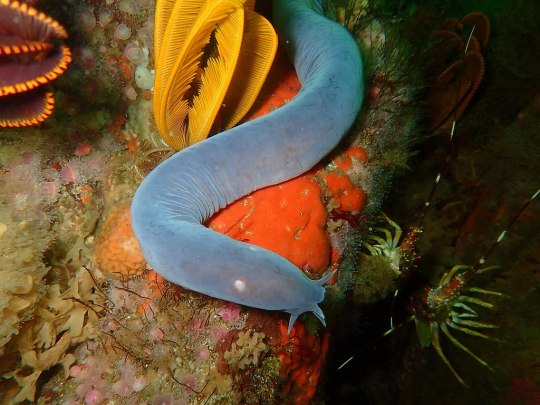

Myxiniformes. This order is known as hagfish, jawless fish which release slime from their skin to protect themselves from predators. They are the only known living species to have a skull but no vertebral column.
Myliobatiformes. This order of batoids includes stingrays and manta rays.
#animals#biology#polls#poll tournament#zoology#hagfish#stingrays#manta rays#fish#rays#Myxiniformes#Myliobatiformes#0xbv0x34
205 notes
·
View notes
Note
we should talk about marine bio things.... do you have a favorite marine organism or group of organisms❓🧑🔬
FUCKING. KICKS DOWN THE DOOR
YES I DO!!
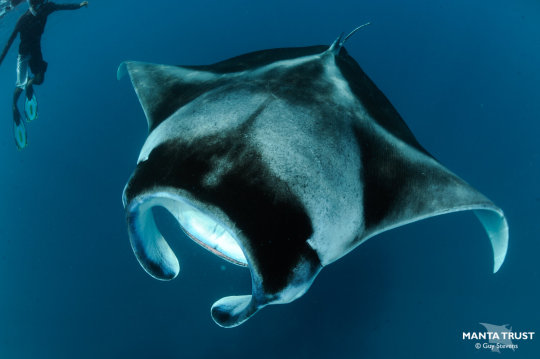

i LOVEEEEE pretty much all of subclass elasmobranchii (and order myliobatiformes) but M. alfredi is my favorite ^^ i’m gonna be working on my second whole marine sci project about it soon! also shoutouts to orcas for having one of my favorite scientific names (FUCKING. ORCINUS ORCA. THATS SO GOOD) and for being a natural predator to the moose
i have so many thoughts on marine bio things i’m deranged about fish
3 notes
·
View notes